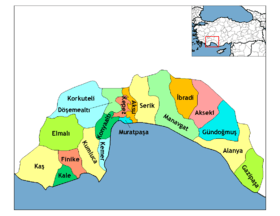Gazipaşa
| Gazipaşa | |
|---|---|
 Gazipaşa | |
| Coordinates: 36°16′22″N 32°18′47″E / 36.27278°N 32.31306°ECoordinates: 36°16′22″N 32°18′47″E / 36.27278°N 32.31306°E | |
| Country |
|
| Province | Antalya |
| Government | |
| • Mayor | Adil Çelik (AKP) |
| • Kaymakam | Muhittin Pamuk |
| Area[1] | |
| • District | 920.52 km2 (355.41 sq mi) |
| Population (2012)[2] | |
| • Urban | 22,332 |
| • District | 47,963 |
| • District density | 52/km2 (130/sq mi) |
| Post code | 07900 |
| Website |
www |
Gazipaşa (Turkish pronunciation: [ɡaˈzipaʃa]) is a town and district of Antalya Province on the Mediterranean coast of southern Turkey, 180 km east of the city of Antalya. Gazipaşa is a quiet rural district famous for its bananas, oranges and international airport of Gazipaşa Airport (IATA shortkey GZP). Gazipaşa district is adjacent to Alanya to the west, Sarıveliler to the north and Anamur to the east.
Geography
The district of Gazipaşa stands on a narrow strip of coast between the Mediterranean Sea and the high Taurus Mountains rising steeply behind (highest point the 2253m "Deliktaş". You can find prehistoric animal remains (shelled sea animals) at many locations in the mountains. Before these were the Taurus Mountains (Paleozoic Age) these peaks were below the sea. The coast road is winding Alanya, but good with four lanes in places making Gazipaşa easy to access from Antalya and Alanya. From Gazipaşa east the road is two lanes but in the process of being improved to four. It is 80 km to the next town Anamur which takes two hours to drive). The remote rocky hillsides are home to snakes, scorpions and other wildlife such as deer, rabbits, wild boar, wild sheep and badgers. There is 50 km of coastline, half of which is sandy beach and rocky stretches with small coves that can be used for swimming. The beaches of Gazipaşa are used as nesting grounds by loggerhead sea turtles. Construction is forbidden in these sea turtle areas.
The local economy depends on agriculture and the land of the coastal strip is used for growing fruits and vegetables, especially citrus fruits and bananas. The mountainous areas have many fruit orchards and in recent years a large number of glasshouses have been built to produce crops such as cucumbers, strawberries and artichokes all year round in both locations. Some grain is grown and there is also much animal husbandry animals in the summer these animals are grazed higher in the mountains. Gazipasa has a dam (Gökçeler Barajı). There is also some forestry and fishing but only small industry. The local council is controlled by the centre-right AKP. Its current mayor is Adil Çelik.
Gazipaşa has not experienced the tourist boom of neighbouring Alanya but there are now efforts being made to attract tourists to the district by building a yacht marina and an international airport. Tourist attractions include some sites from antiquity, caves, beaches, the opportunity to appreciate the marvellous Taurus Mountain scenery with mountain walking or motor touring.
The new Gazipaşa Airport will serve the tourist economies of Alanya, Anamur and Yeşilöz.
History
This is a part of the world with a long history, and there is evidence of Hittite settlement going back to 2000 BC, and it is assumed that this coast was settled long before that. The Ancient Greek city of Selinus was established here on the River Kestros (today called Hacımusa) by 628 BC, as part of the kingdom of Cilicia. In 197 BC the area passed into the hands of the Ancient Romans, and in the 1st century AD the Emperor Trajan died here after falling ill while journeying along the Mediterranean coast. His body was taken by his successor Hadrian for burial in Rome and for a period the town was named Traianapolis.
The Romans were succeeded by the Byzantines. Byzantines were succeeded by Armenian Kingdom of Cilicia who lost the area to the Seljuk Turks of `Ala' ad-Din Kay-Qubad in 1225. Selinus was retaken briefly by Armenians before the conquest of Karamanids in the end of the 13th century. During the area of the Anatolian beyliks the coast including Selinti was controlled by the Karamanid clan of Konya and was brought into the Ottoman Empire in 1472 by Gedik Ahmet Pasha, naval commander of Sultan Mehmet II. The 17th century traveller Evliya Çelebi records Selinti as a group of 26 villages, with a well-kept mosque on the seafront along with a jetty for boats to Cyprus, and green mountains behind.
Archaeological research continues and in 2004 a team from Florida State University found a small bronze statue of Pegasus dating back to 300 BC in the waters off Gazipaşa; it is now in the Museum of Alanya.
We can list the castles in Gazipasa as Selinus, Iotape, Lamos (Adanda), Nephelis and Antiochia ad Cragum.
Twin towns — sister cities
Gazipaşa is twinned with:
Gallery
-
Sleeping old man in Gazipaşa
http://www.gazipasa.bel.tr/foto-galeri.aspx
References
- ↑ "Area of regions (including lakes), km²". Regional Statistics Database. Turkish Statistical Institute. 2002. Retrieved 2013-03-05.
- ↑ "Population of province/district centers and towns/villages by districts - 2012". Address Based Population Registration System (ABPRS) Database. Turkish Statistical Institute. Retrieved 2013-02-27.
External links
- Panorama image
- Gazipasa municipality's official website (Turkish)
- Investigation of the construction history of the supposed cenotaph of Emperor Trajan (Deutsches Archäologisches Institut)
- Antiochia ad Cragum (University of Nebraska)
- Renting Villas In Alanya
- Booking Flights to Gazipasa Airport
- Booking Flights to Alanya-Antalya Airport
- Mitchell, S., R. Talbert, T. Elliott, S. Gillies. "Places: 648772 (Selinous/Traianopolis)". Pleiades. Retrieved March 8, 2012.
- Selinos coins
